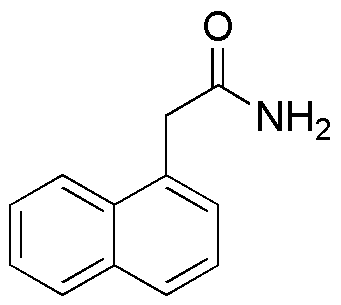1-Naphthalene acetamide is widely utilized in research focused on:
- Pharmaceutical Development: This compound serves as a key intermediate in the synthesis of various pharmaceutical agents, particularly in the development of analgesics and anti-inflammatory drugs.
- Organic Synthesis: It is commonly used in organic chemistry as a building block for creating more complex molecules, enabling researchers to explore new chemical reactions and pathways.
- Polymer Chemistry: 1-Naphthalene acetamide is employed in the production of specialty polymers, enhancing their properties such as thermal stability and mechanical strength.
- Biological Research: The compound is utilized in studies investigating its effects on biological systems, helping researchers understand its potential as a therapeutic agent.
- Material Science: It finds applications in the development of advanced materials, including coatings and adhesives, due to its unique chemical properties that improve adhesion and durability.
General Information
Properties
Safety and Regulations
Applications
1-Naphthalene acetamide is widely utilized in research focused on:
- Pharmaceutical Development: This compound serves as a key intermediate in the synthesis of various pharmaceutical agents, particularly in the development of analgesics and anti-inflammatory drugs.
- Organic Synthesis: It is commonly used in organic chemistry as a building block for creating more complex molecules, enabling researchers to explore new chemical reactions and pathways.
- Polymer Chemistry: 1-Naphthalene acetamide is employed in the production of specialty polymers, enhancing their properties such as thermal stability and mechanical strength.
- Biological Research: The compound is utilized in studies investigating its effects on biological systems, helping researchers understand its potential as a therapeutic agent.
- Material Science: It finds applications in the development of advanced materials, including coatings and adhesives, due to its unique chemical properties that improve adhesion and durability.
Documents
Safety Data Sheets (SDS)
The SDS provides comprehensive safety information on handling, storage, and disposal of the product.
Product Specification (PS)
The PS provides a comprehensive breakdown of the product’s properties, including chemical composition, physical state, purity, and storage requirements. It also details acceptable quality ranges and the product's intended applications.
Certificates of Analysis (COA)
Search for Certificates of Analysis (COA) by entering the products Lot Number. Lot and Batch Numbers can be found on a product’s label following the words ‘Lot’ or ‘Batch’.
*Catalog Number
*Lot Number
Certificates Of Origin (COO)
This COO confirms the country where the product was manufactured, and also details the materials and components used in it and whether it is derived from natural, synthetic, or other specific sources. This certificate may be required for customs, trade, and regulatory compliance.
*Catalog Number
*Lot Number
Safety Data Sheets (SDS)
The SDS provides comprehensive safety information on handling, storage, and disposal of the product.
DownloadProduct Specification (PS)
The PS provides a comprehensive breakdown of the product’s properties, including chemical composition, physical state, purity, and storage requirements. It also details acceptable quality ranges and the product's intended applications.
DownloadCertificates of Analysis (COA)
Search for Certificates of Analysis (COA) by entering the products Lot Number. Lot and Batch Numbers can be found on a product’s label following the words ‘Lot’ or ‘Batch’.
*Catalog Number
*Lot Number
Certificates Of Origin (COO)
This COO confirms the country where the product was manufactured, and also details the materials and components used in it and whether it is derived from natural, synthetic, or other specific sources. This certificate may be required for customs, trade, and regulatory compliance.


